Leon, Bertram Gordon Paul (Flying Officer)
Killed in Flying Accident 1960-December-07
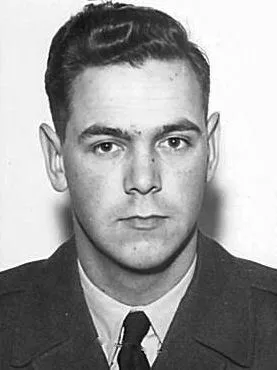

Birth Date: 1937-January-14
Born: Halifax, Nova Scotia
Parents: Son of Bertran Underwood and Gladys Alberta Leon of Fort Nelson, British Columbia.
Spouse: Husband of Octavia June Leon. Father of Linda Leon.
Home: Halifax, Nova Scotia
Enlistment: Halifax, Nova Scotia
Enlistment Date: 1955-October-06
Service
RCAF
Unit
428 Sqn- Squadron
Usque Ad Finem To the Very End
Base
Rank
Flying Officer
Position
Service Numbers
161644
Home
Crew or Other Personnel
Canuck 18571
Canuck serial: 18571
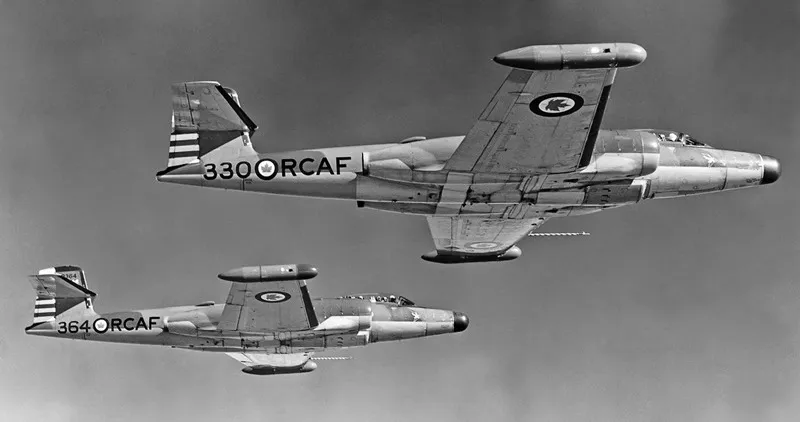
The Avro Canada CF-100 Canuck (affectionately known as the "Clunk") was a Canadian jet interceptor/fighter in service during the Cold War both in NATO bases in Europe and as part of NORAD. The CF-100 was the only Canadian-designed fighter to enter mass production, serving primarily with the RCAF and the Canadian Armed Forces, and also in small numbers in Belgium. For its day, the CF-100 featured a short takeoff run and high climb rate, making it well suited to its role as an interceptor.
Production consisted of 5 pre-production CF-100 Mk. 2 aircraft, 74 machine gun armed CF-100 Mk. 3 aircraft, 280 CF-100 Mk. 4 aircraft armed with both machine guns and rocket pods, and 331 CF-100 Mk. 5 aircraft armed only with rocket pods. Harold Skaarup web page
Unit Desciption
428 Sqn Usque Ad Finem ("Ghost")
History of the Squadron during World War II (Aircraft: Wellington III, X, Halifax V, II, Lancaster X)
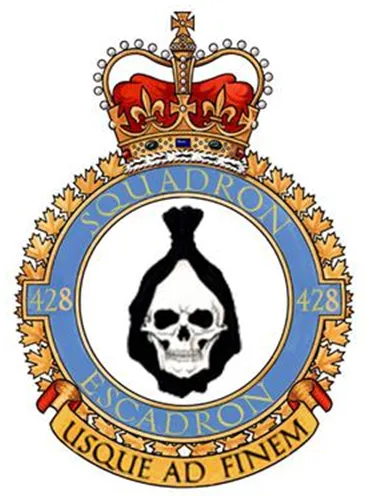
No 428 Squadron was the ninth long-range heavy bomber squadron and the 26th RCAF squadron formed overseas during the Second World War. It was formed at RAF Dalton in Yorkshire, England ![]() on November 7, 1942. The squadron was initially assigned to No. 4 Group RAF Bomber Command. With the creation of No. 6 Group RCAF, the squadron was reallocated on January 1, 1943 operating with it until April 25, 1945.
on November 7, 1942. The squadron was initially assigned to No. 4 Group RAF Bomber Command. With the creation of No. 6 Group RCAF, the squadron was reallocated on January 1, 1943 operating with it until April 25, 1945.
The squadron was originally equipped with Vickers Wellington Mk III and X, and its first operational mission was on January 26–27, 1943, when five Wellingtons bombed the U-Boat base at Lorient in Brittany, on the Bay of Biscay. In the early part of June 1943, the squadron moved to RAF Middleton St. George, Durham ![]() where it remained for the remainder of the war. Around this time the squadron was converted to Handley Page Halifaxes (Mk Vs, and later supplemented by Mk II Series IIA). In January 1944, Halifax bombers from No. 428 Squadron participated in the first high-level mining raid "Gardening", when mines were dropped by parachute from 15,000 feet (4,570 m) over Brest on 4/5 Jan and Saint-Nazaire on 6/7 Jan 1944. The squadron flew its last sortie with the Halifax on June 12, 1944 then converted to the Canadian-built Avro Lancaster Mk X, the first sortie taking place on June 14, 1944.
where it remained for the remainder of the war. Around this time the squadron was converted to Handley Page Halifaxes (Mk Vs, and later supplemented by Mk II Series IIA). In January 1944, Halifax bombers from No. 428 Squadron participated in the first high-level mining raid "Gardening", when mines were dropped by parachute from 15,000 feet (4,570 m) over Brest on 4/5 Jan and Saint-Nazaire on 6/7 Jan 1944. The squadron flew its last sortie with the Halifax on June 12, 1944 then converted to the Canadian-built Avro Lancaster Mk X, the first sortie taking place on June 14, 1944.
For the final phase of the air campaign against Germany, the squadron took part in day and night raids, with its last operational sortie taking place on April 25, 1945, when 15 Lancasters bombed anti-aircraft gun batteries defending the mouth of the Weser, on the Frisian Island of Wangerooge. The squadron remained in service in the United Kingdom until the end of May 1945, then flew to Yarmouth, Nova Scotia ![]() . The squadron was intended to be part of the "Tiger Force" to carry on the war against Japan, but the Japanese surrender led to the disbandment of the force. The squadron was therefore disbanded at Yarmouth in September 1945.
. The squadron was intended to be part of the "Tiger Force" to carry on the war against Japan, but the Japanese surrender led to the disbandment of the force. The squadron was therefore disbanded at Yarmouth in September 1945.
In the course of WWII operations, the squadron flew 283 missions involving 3467 individual sorties. 84 aircraft were lost and a total of 9378 tons of bombs were dropped. the aircrew earned 2 DSO's, 71 DFC's, 2 CGM's and 6 DFM's. Battle Honours were: English Channel and North Sea 1943-44, Baltic 1944, Fortress Europe 1943-44, France and Germany 1944-45, Biscay Ports 1943-44, Ruhr 1943-45, Berlin 1943-44, German Ports 1943-45, Normandy 1944, Rhine, Biscay 1943-44. Wikipedia, Kostenuk and Griffin
Squadron History (Bomber Command Museum PDF)
Maps for Movements of 428 Squadron 1942-45
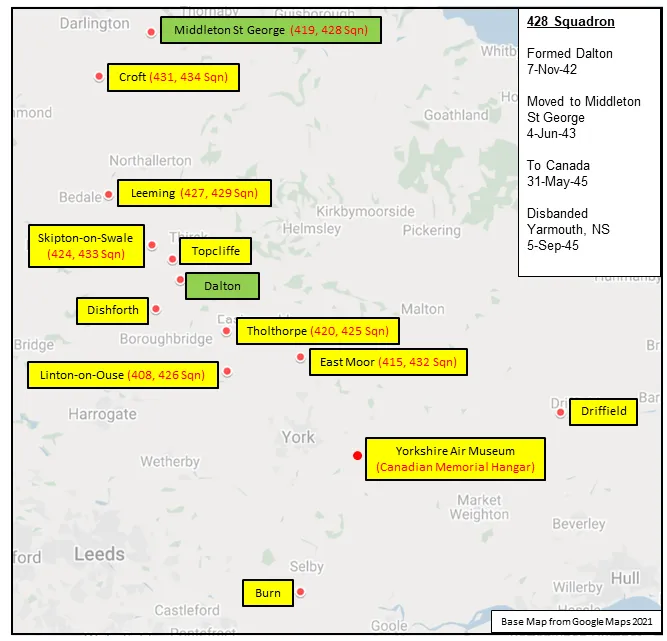
428 Squadron History Summary 1942-45
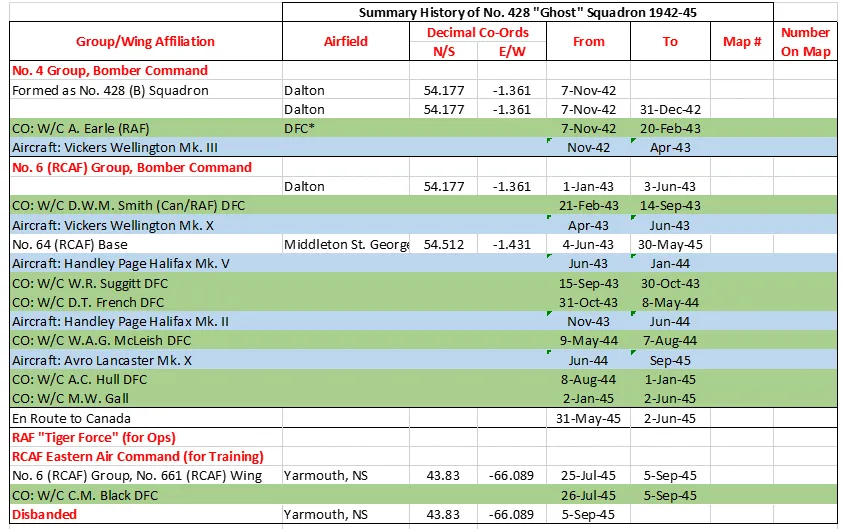
History of the Squadron Post-WWII (Aircraft: Canuck)
The squadron was re-activated as the fifth Avro Canada CF-100 Canuck equipped squadron, on June 21, 1954, at RCAF Station Uplands ![]() as 428 All-Weather (Fighter) Squadron. It was re-activated, as one of nine Canadian based RCAF squadrons, to be operating under the new RCAF Air Defence Command, protecting North American airspace from Soviet intruders and long range bombers. The squadron was finally disbanded on 1 June 1961.
as 428 All-Weather (Fighter) Squadron. It was re-activated, as one of nine Canadian based RCAF squadrons, to be operating under the new RCAF Air Defence Command, protecting North American airspace from Soviet intruders and long range bombers. The squadron was finally disbanded on 1 June 1961.
